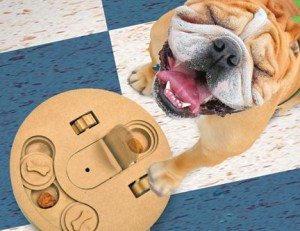Hi Meira,
I’m having a problem with my dog. He is 3 year old pit bull and is neutered, and he normally gets good exercise and good walks, but a couple months ago he had to have leg surgery, and he was put on ‘bed rest’ for over a month. He’s allowed to move around now, but we can’t let him go wild and run around like crazy.
The problem is that he barks non stop when we are gone and I’m having trouble finding the solution here. I have tried everything I can think of but now my landlord has put the pressure on, and has told me to get an anti bark collar, or I will have to get rid of my dog if I cannot stop the barking.
I bought and tried a citronella collar, but that did nothing. I don’t want to have to get an electric anti barking collar, but my landlord is really putting the pressure on us. Our neighbors are complaining a lot.
This has been killing me and I’ve been crying ever since the landlord has told me to take care of the problem or else. In the meantime we are also looking at moving away, but I really need some help now, before things get out of hand. Any suggestions would be very helpful.
Thank you,
Kelly
Hi Kelly,
I am sorry to hear about what you are going through. Problem barking can definitely be an issue when it causes tension with your neighbors and your landlord. Thanks for writing in with such a good question. You are definitely not alone in this. It’s a big problem with many dogs who live in apartments or other shared spaces with close neighbors. This doesn’t mean that it is unsolvable though. There is light at the end of the tunnel, and it won’t require an anti bark collar either, so you don’t have to worry about that.
The thing is that dogs bark for a variety of reasons, and while it is not a huge part of their communication language, it is normal for a dog to bark. Some breeds are also more vocal than others, especially hunting breeds and hounds, while there are others who hardly bark at all. But there is a big difference between regular barking, and the constant problem barking that you’re describing.

To help tackle the problem of the constant barking, we first need to determine the reason for the barking, and the type of barking that your dog is engaging in. Problem barking can arise from different issues, and it is important that we figure out what the dog’s emotional state is, so that we can help him. The dog is stressed out in some way, and is not in a healthy emotional place.
This is why anti barking collars are not very helpful, as they don’t deal with the underlying reasons for the barking. The dog is corrected for an unwanted behavior, but is given no acceptable alternative. And while the collar gives a correction for a behavior, we need to keep in mind that behavior is driven by emotion, and this is what we need to deal with if we are to really help our dogs.
We also need to keep in mind that barking is a very self rewarding behavior to a dog. As I mentioned earlier, dogs bark for a variety of reasons. Problem barking can arise from boredom, over excitement, anxiety, to get attention, when theyíre lonely, frustrated, or in fear. In either case, problem barking has been reinforced as a rewarding behavior for the dog in some way. Often times it is also a stress reliever in a problem barking dog. And if you’ve read any of my posts before, you know that dogs always do what works for them. Unfortunately for you and your neighbors, this barking is working for your dog in some way. Remember, we need to reward the behaviors that we do want, we need to ensure that we are not inadvertently rewarding those unwanted behaviors, and ideally, we should try to manage fido’s world so that he doesn’t get the chance to get reinforced for an unwanted behavior in the first place. We have to remove the reinforcers or the motivators for the unwanted behavior to make the behavior diminish. Removing this makes his barking behavior too expensive, and we all know that dogs only do what pays off best for them, and that they never do anything without a reason.
It’s also helpful if we can determine the type of bark, the tone and the pitch, as well as there are different kinds of barks. Warning barks are usually loud, sharp and full of authority. This isn’t normally considered problem barking though. Anxious barking is often high pitched, and is sometimes self soothing to the dog. Sometimes they may whine as well. This often appears in dogs who have separation anxiety. Excited or playful barking sounds playful and upbeat, and often appears when the dog is looking forward to something, or while they are playing. Attention seeking barking is repetitive, and says just what the dog is trying to convey: “I’m here, here I am, I’m here, here I am!”. The sound of a dog who barks out of boredom tends to be annoying, and sounds like the dog just barks to hear itself bark. It can sometimes sound sad too, as the barking seems pointless.

I also suggest, if at all possible, to record the dog when you are not home. You can either record with a web cam, or use skype. I find this helpful as well because we can also see what the dog is doing WHILE it is barking. Is your dog destructive at all? Is he pacing back and forth in front of the door, or windows? Is he barking at a ball that’s rolled under the couch? Is there anything else that accompanies the constant barking while you’re out? The recording can also help determine if in fact your dog is ‘constantly’ barking. A frustrated neighbor may understandably exaggerate how much your dog is actually barking.
As I mentioned earlier, there are a few different causes the lie behind problem barking. I have actually written other posts about some different reasons and remedies for some cases, which can be found in the archives: This article is regarding a dog who barks when stimulated by the doorbell, people, or dogs outside, and so on. This one deals with separation anxiety.
From the information that I have, I don’t believe that your dog is engaging in stimulus barking, and nor do I believe that he is going through some sort of separation anxiety. You can check both posts, to rule them out, but I believe that your dog is barking due to not having enough to do, that it is out of boredom.
You mentioned that he had surgery, and that his healing time was basically bed ridden time, that he wasn’t allowed to run around, which is totally understandable.

I am not sure of the energy level of your dog, but it sounds like he received a good amount of exercise before he went in for surgery. And this is something that I am sure your dog loved, and also missed very much once that energy draining venue was taken away. We all know that our dogs need exercise, and require physical stimulation…but they also require, as much, if not even more mental stimulation.
Our dogs of today are not the dogs of yesterday, working as their breeding intended. Many of our dogs today are totally unemployed. And on top of being unemployed, your dog was ‘bed ridden’ as well. This doesn’t make for a happy, well adjusted dog. But the other side of the coin is that working a dog out mentally is not really that difficult at all. There are things that you can do with him, as well as things that he can do on his own, whether you are home or not.
While you’re home with your dog, here are some games that you can play together that will give him some much needed mental stimulation:
1. Where’s The Treat?
Start with three (or four) red plastic drinking cups (margarine tubs would work too). Show your dog that you have a treat or a favorite small toy. Put your dog in a SIT/STAY or DOWN/STAY about 10 feet away, then make sure he can see you as you place his prize under one of the buckets. Then say WHERE’S THE TREAT? and encourage him to smell the buckets, give him lots of praise when he paws, sits beside, or barks next to the correct bucket, and then lift it up so he can claim his reward. You can up the difficulty level by changing the position of the buckets after you place the treat or pretending to put treats under multiple buckets. (This game is one of Tikka’s favorites actually!)
2. Hide and Seek
This old standby is still loads of fun for you and your dog. Have your dog STAY in one room. Go into another room and hide. Call your dog. Try not to give away your location by laughing! Kids love to play this game with the family dog. (Bullet prefers this to the cup game.)
3. Clean Up Time!
Teach your dog to CLEAN UP after playtime by picking up his toys and putting them back in the toy box. Have your dog pick up a toy while you hold the toy box up to him. Tell him to DROP IT. When he does, give him lots of praise. Repeat with the next toy. Once he gets the idea, put the toy box on the floor and guide the dog over to it and say DROP IT. Keep it fun and simple, and use the same words each time for every command.
4. Find It!
Put your dog in a SIT/STAY. Show your dog a toy or treat and put it on the floor so the dog can see it. Say FIND IT! Naturally, your dog will enthusiastically and hopefully, easily find the toy or treat. Make the next prize a bit more difficult to locate, say, behind a chair. Continue to vary treat placement, or, for a real challenge, set up a roomful of hidden delights in advance. Watch your dog as he searches, and tap your foot and give an OOH or gasp to get him excited about the ones he’s missed.
Work for Dinner
You can also make fido work for his dinner as well. There’s no rule anywhere that our dogs need to get fed from a bowl that’s on the floor. How boring! So much more interesting to use our smarts to get our dinner! The Muffin Tin Game is a favorite. Get a regular metal muffin tin, (the bigger the better!) and put some yummy treats in SOME of the cups, and then take some tennis balls, and use them to cover ALL the cups, so that the dog needs to work to get his yummies.
You can also strew his meal through towels or old blankets, making them loose when starting out, only increasing the difficulty once your dog becomes more proficient at it, and let your dog forage through it for his kibble. You can also take a large 2 lb water/soda bottle (making sure to remove the cap) and shove a carrot almost all the way into the bottle, leaving some out of the top, so that your dog can work on that. Please make sure to only practice these games while the dog is supervised.
Then there are some amazing food puzzle and intelligence toys out there on the market, all of which are an excellent way to create some mental stimulation. Aikou has some very good ones, and Nina Ottosan has some of the best ones, in my opinion. (I love the different level puzzles, that can be changed to increase/decrease challenging levels.)


When you’re not home, you can also feed fido his meals in either a Kong Wobbler, a treat ball, or even a regular Kong. Once your dog gets the hang of the stuffed Kong, you can make it even more challenging for him by

freezing it first, so that it lasts that much longer. There is no end to what you can stuff your dog’s Kong with, too. There are many recipes you can find online as well. I also suggest getting a few of them (being a pit bull, you might want the black ones) and stuffing them all, so that you always have one at your disposal.
All of these things will help to tire fido out, to help him keep calm and sated.
If none of this works, then you can set up trails where you leave the house for very short periods of time, and come back in BEFORE he barks, and then reward him for being quiet. You’d have to do this with many repetitions, slowing increasing the time increments that you are out of the house. Check with the post I have above for separation anxiety, as that is the protocol you’d use in this case.
There is light at the end of the tunnel! With enough practice, your dog can learn to be a much quieter fellow in the house!
Good luck and happy training!
 Montreal Dog Blog Montreal's Online Dog Park
Montreal Dog Blog Montreal's Online Dog Park




